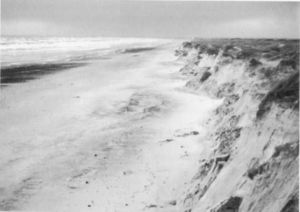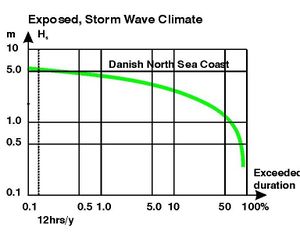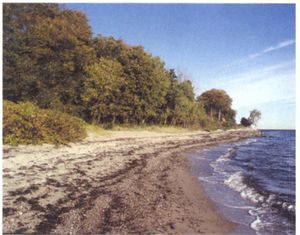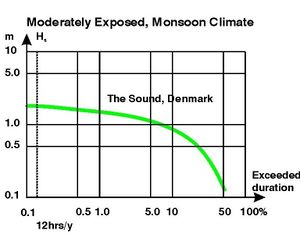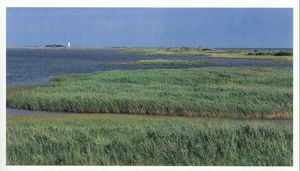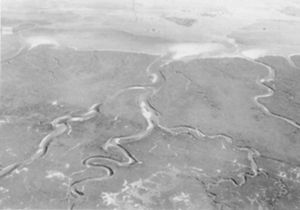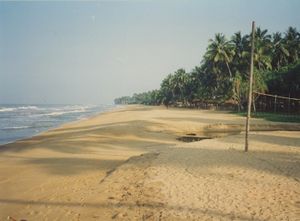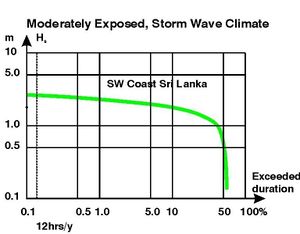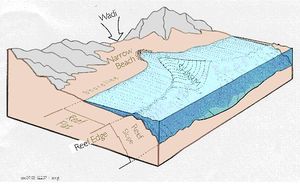Difference between revisions of "Classification of coastal profiles"
m (→Further reading) |
m |
||
| Line 119: | Line 119: | ||
[[category:Theme 5]] | [[category:Theme 5]] | ||
| − | |||
| − | |||
[[Category:Geological processes, soil and minerals]] | [[Category:Geological processes, soil and minerals]] | ||
[[category:Geomorphological processes and natural coastal features]] | [[category:Geomorphological processes and natural coastal features]] | ||
| + | [[Category:Hydrodynamics]] | ||
Revision as of 18:02, 24 November 2007
The theoretical equilibrium profile is often recognised in the real coastal profiles, but deviations often occur due to variations in the seabed material and the presence of bars and due to the influence of tide, etc. Another reason can be that the actual profile has not yet reached the equilibrium shape, which is important information in relation to the analysis of the predominant processes at a specific site. Rocky coastlines that exist adjacent to littoral coastal profiles have only a minor influence on the coastal profile but may have a major influence on the shape and stability of the shoreline.
Contents
Exposed Littoral Dune or Cliff Coast
The exposed littoral coast is characterised by a wide sandy beach and a wide shoreface with up to three bars; the coast can consists of dunes or cliffs.
If the geology is dominated by semi-hard material, such as glacial till or sandstone, boulders and till/sandstone may be exposed to some extent in the coastal profile and the resulting receding coast will consist of till/sandstone cliffs, see Fig. 1. below. In such cases, the coast can be characterised as an Exposed Littoral Cliff Coast, as opposed to an Exposed Littoral Dune Coast where the dunes dominate. There is often a gradual transition between these two types of coasts.
These types of coastal profiles typically occur in connection with coastlines bordering medium large to large water bodies with dimensions from 100 km and upwards, storm wave climates with Hs,12h/y larger than 3m, micro to moderate tidal regimes, and moderate to macro storm surge regimes. There will often be a positive correlation between onshore wind speeds/wave heights and storm surge. The annual gross littoral transport will be large, from 50,000 m3 up to more than 1 million m3 per year. The littoral zone will be wide, typically from 300 m and up to more than 1km.
The exposed coasts are characterised by great mobility and consequently the associated problems can also be severe. Management of such shorelines requires great care.
Typical examples of exposed coastal profiles are found along the European coasts bordering the North Sea, the Atlantic and to some extent the Mediterranean and the North- and the South American coasts bordering the Atlantic and the Pacific Ocean.
Moderately Exposed Littoral Dune or Cliff Coast
The moderately exposed littoral coast will be characterised by a narrow beach and shoreface, normally with only one bar; the coast can consist of small dunes or cliffs.
This type of coastal profile is normally seen in connection with coastlines facing relatively small bodies of water with typical dimensions from 10 to 100 km, storm wave climates with Hs,12h/y between 1 and 3 m, micro to moderate tidal regimes and up to macro storm surge regimes with a positive correlation between surge and onshore winds/waves. The gross littoral transport will be relatively small, in the order of 10 – 50,000 m3 per year, and the littoral zone will be relatively narrow, typically 50 to 300 m.
Typical examples of such coasts are found along inner waters of moderate size.
Protected or Marshy Coast
The protected coast will be characterised by a narrow beach or the complete lack of a sandy beach. The shoreface will be narrow and without any bars; the coast is often covered with vegetation right out to the beach and sometimes it is marshy with only very low cliff-like scars in the coastal formations. This type of coast occurs under arctic, temperate and subtropical conditions.
This type of coast is normally seen in connection with coastlines out to small bodies of water, for example fjords, estuaries and lagoons with typical dimensions of less than 10 km. However, such coasts can also occur out to larger bodies of water if one or more of the following conditions are fulfilled:
- The wind and wave climate is mild
- The geology of the area has provided a very shallow nearshore zone, which protects the shore against severe wave action
- Strong onshore winds are correlated with low water (negative surge)
This type of coast can occur under micro to moderate tidal regimes and up to macro storm surge regimes. The littoral transport will be less than 5,000 m3 per year and there will be hardly any littoral zone.
The protected coast will normally not erode, but it can be exposed to flooding. Protected coasts will normally be of poor recreational value.
Tidal Flat Coast
Tidal flat coasts are characterised by a very wide and mildly sloping foreshore, the so-called tidal flats. This type of coastal profile develops when tidal processes dominate over wave processes. The relative importance of the tide and the wave regime can be expressed by the relative tide range RTR, which is defined as[1]:
- RTR = MSR/Hb
where MSR is the mean spring tidal range and Hb is the breaker wave height.
As a rule of thumb a tidal flat will develop when RTR = MSR/av.Hb>15, where the yearly average significant wave height is inserted for Hb.
This definition does not account for the influence of storm surge, however tidal flats often occur for combined macro-tidal and macro-surge conditions. Negative correlation between storm surge and wave conditions may lead to the formation of a very flat shoreface similar to a tidal flat. The width and character of the backshore on tidal flat coasts will mainly depend on the storm surge conditions and the general geology and morphology of the area. If the coast is low, it will often be exposed to flooding during combined high tide and storm surge. In this case sea defences, such as dikes will often have been constructed to protect the hinterland. If the coast is high, there will often be a sandy backshore and cliffs will back the coastline.
Tidal flat coasts are most frequently found in connection with moderately exposed to protected conditions combined with non-tropical climates. Under tropical conditions, the tidal flat will often be vegetated by mangrove, which changes the character of the tidal flat, see below.
Under protected conditions, such as in estuaries, the tidal flat will often consist of fine sand and mud, whereas under more exposed conditions, the tidal flat will mainly consist of sand. However, many variations of tidal flat coasts exist. The specific characteristics very much depend on the type and amount of sediments supplied from nearby rivers.
The sediment transport processes on tidal flats are complicated as they are influenced both by the tidal currents and by the waves. This means that there are considerable longshore as well as cross-shore transport processes. Furthermore, the tidal flats are separated in sections by tidal channels and creeks of different dimensions. Both non-cohesive as well as cohesive sediments are often involved in the transport processes, which further complicates the picture.
These types of coasts are seldom used for traditional beach recreation, as they provide no attractive beaches; however, the tidal flats often constitute important habitats. Coastal erosion is normally not a problem, whereas flooding is often a major problem.
Monsoon Coast or Swell Coast
Monsoon wave climates and swell wave climates are characterised by persistent wave exposure with relatively small waves, typically with average wave heights in the order of Hs = 1-2 m, and extreme waves less than say Hs = 3 m. This provides a persistent and uniform exposure at water depths up to 3–4 m, and hardly no exposure beyond that depth. These coastal conditions often occur in environments with an abundant supply of sand as well as of fine sediment from tropical rivers.
This combination of available mixed sediments and a fairly constant wave climate results in a very pronounced sorting of the sediments. This results in the formation of a narrow sandy beach and a sandy shoreface out to a water depth of 3–4 m. The width of the shoreface is often less than 2-300 m.
The beach and shoreface material often consists of well-sorted medium sand. Beyond this sandy shoreface, the bed material often shifts abruptly to silt or mud and the slope of the profile becomes considerably more gentle. The fine offshore bed material is only suspended and transported during the rougher part of the monsoon period. Under these conditions, there is considerable transport of fine material on top of the littoral transport of sand.
The monsoon wave climate is seasonal, whereas this is seldom the case for swell climates. The monsoon coasts are normally only used for recreation in the calm period as the waves are too rough in the monsoon period. Furthermore, the water is often turbid during much of the monsoon period.
If there is no supply of sand to the coast, monsoon and swell coastlines are often exposed to erosion. Other typical problems are sedimentation in ports and the closure of river mouths due to the seasonal pattern of precipitation and wave conditions.
Muddy Coast with Mangrove Vegetation
A muddy coast is characterised by a muddy shoreface, sometimes in the form of muddy tidal flats, and the lack of a sandy shore. The area exposed to the tidal variation, or part of it, is vegetated by mangrove.
This type of coastline occurs in tropical climates where rivers supply abundant fine material to the coastal zone. Normally the wave exposure is low to moderate and the tidal regime can be any type.
The coast in connection with this coastal profile is often low wetland exposed to flooding. Dikes are often built in such areas.
The mangrove constitutes an important part of such a profile, both biologically and with respect to the stability of the coastal profile. Cutting of the mangrove causes very severe problems for such a coast as it decreases the bio-diversity and causes erosion and flooding.
Coral Coast
Coral coastlines are restricted to tropical climates with clean, clear and nutrient-poor water without suspended material. Furthermore, the corals require a firm seabed, to which they can adhere. Corals are small animals, which produce a hard skeleton composed of carbonate. The continued growth of these skeletons, on top of the old skeletons, produces the coral reef. The coral reefs and related features are very fragile, as they are composed of the skeletal remains of living coral animals, which means that their survival are dependent on both physical and biological conditions. The most common type of coral coast is the fringing coral reef type, the development of which is illustrated in Fig. 8. below.

The coral coasts will themselves produce coral debris and coral sand, whereby originally hard coastlines over time are converted into sandy beaches fronted by coral reefs. In this way they enter into a category of sandy coasts, the so-called carbonate beaches. A typical carbonate beach is seen in Fig. 7. at the top of this article.
The coral coast normally occurs in originally rocky areas in the tropics, either in rainforest climates, but away from sediment-carrying rivers, or in arid climates (desert climate such as the Red Sea and the Arabian Gulf). This means that coral coasts in a rainforest climate are most often seen on small islands, where there is no supply of fine sediments to the nearshore zone. The typical situation for a fringing coral reef coastline along the Red Sea coast is presented in the figure to the left.[3].
Due to the presence of the reef, the shoreline will hardly be exposed to waves, as they break on the reef edge. This results in a narrow and not very attractive beach, which is not suitable for bathing, as it is fronted by the shallow reef flat, see example from the Red Sea coast in Fig. 10.
In the hot arid climate rivers are normally dry, a so-called wadi. However, during the rare but violent thunder showers in the mountains, the wadies are transformed to violent rivers carrying lots of sediments. The sediment damages the reef at the outlet of the wadi whereby a small semi-protected bay may be formed, a so-called sharm or marsa.
Such locations are very attractive locations for local fishermen, as they provide partly protected natural harbours, where boats can be moored/landed safely. Furthermore these locations are very attractive from a recreational point of view, as they provide attractive semi-protected beaches and sufficient water for swimming. In such environments the beaches often consist of sand carried to the coast by the wadies, which means that the beach does not consist of carbonate sand, see example from the Red Sea in Fig. 11.
References
- ↑ Masselink, G. and Huges, M.G., 2003. Introduction to Coastal Processes and Geomorphology. Published by Hodder Arnold. ISBN 0 340 76410 4
- ↑ Mergner H, Schuhmacher H (1974)
- ↑ Red Sea Sustainable Tourism Initiative (RSSTI) Guidelines, 2004. DHI Water & Environment as sub consultant to PA Consulting for RSSTI, financed by USAid.
Further reading
- Mangor, Karsten. 2004. “Shoreline Management Guidelines”. DHI Water and Environment, 294pg.
Please note that others may also have edited the contents of this article.
|
